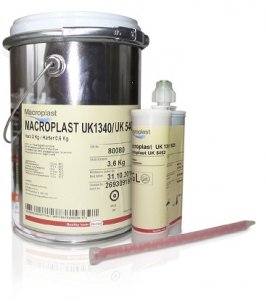
Because Macroblast U.K. 1340 requires no heat, cure process, or tempering, it minimizes energy consumption, helping to control energy costs for blade manufacturers.
Henkel has introduced a new high-performance polyurethane adhesive that prevents crack propagation on wind blades and delivers excellent long-term structural integrity on turbine assemblies. The first ever Germanischer Lloyd (GL)-approved polyurethane adhesive, Macroplast UK 1340 cures rapidly at room temperature, reduces production costs, and shortens production cycles by 15 to 30%. GL requirements primarily relate to an adhesive’s tensile shear strength, resistance to aging, creep behavior, and glass transition temperature.
Macroplast UK 1340 has demonstrated a tensile shear strength exceeding 20 MPa at -40 to 80°C and a Tg of 65°C and higher. The adhesive has demonstrated superior dynamic fatigue strength, which lets wind blades handle deflection, dynamic load, and stress on the adhesive bond line, while it reduces the risk of stress cracking.
Macroplast UK 1340 passed a four month test conducted by the Fraunhofer Institute for Wind Energy and Energy System Technology IWES where a 40-m blade was subjected for four months to stresses and strains that would normally occur over 20 years. The bonded joints passed all static and dynamic load tests specified in the IEC 61400-23 standard to determine the rated load and fatigue behavior of the blade. The test criteria specified for approval of wind energy plants were met without any problems, and turbine OEM’s specifications were also satisfied in this test.
The material is a two-part adhesive consisting of a resin and a hardener. When mixed, the adhesive cures in just 60 to 80 min. at low reaction temperatures up to 75°C, significantly reducing production time and minimizing thermal loading that can lead to stress cracking. The adhesive’s cure speed can be adjusted for the needs of the manufacturer, allowing faster blade production and greater yield per mold (1MPa in 4 hours at 20°C).
Because the material requires no heat cure process or tempering, it minimizes energy consumption, helping to control energy costs for blade manufacturers. Low reaction temperatures also preserve the integrity of heat sensitive foam inserts.
In addition to blade bonding, the new two-component polyurethane adhesive is also being used in other structural bonding applications on turbines including bonding components to the rotor blade and securing the ladder to the tower.
Henkel Windpower
www.henkelna.com/windpower.
Filed Under: News, O&M




